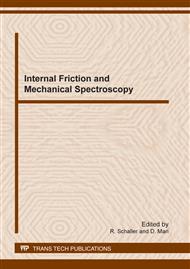p.122
p.131
p.137
p.143
p.149
p.155
p.161
p.167
p.173
Low Frequency Relaxation Effect Observed in Al-Mg Alloy
Abstract:
Al-12 wt% Mg alloys have been studied by isothermal mechanical spectroscopy. The samples were quenched then annealed at various temperatures. Experiments were performed in a very large frequency range (10-4 Hz – 50 Hz) between room and solidus temperatures. For each temperature of measurement, experiment started after complete microstructure stabilization of the sample and therefore the transient effects due for instance to β (( and β′ precipitation were not observed. Nevertheless, a new relaxation effect was obtained in the reversion temperature range. This effect is not thermally activated. It is maximal at about 0.1 Hz and increases with the temperature of measurement. It completely disappears after annealing at solid solution temperature and successive slow cooling and therefore is linked to the β precipitates. This effect is interpreted as a phase transformation at the precipitate surface induced by the applied stress.
Info:
Periodical:
Pages:
149-154
Citation:
Online since:
January 2012
Authors:
Price:
Сopyright:
© 2012 Trans Tech Publications Ltd. All Rights Reserved
Share:
Citation:


